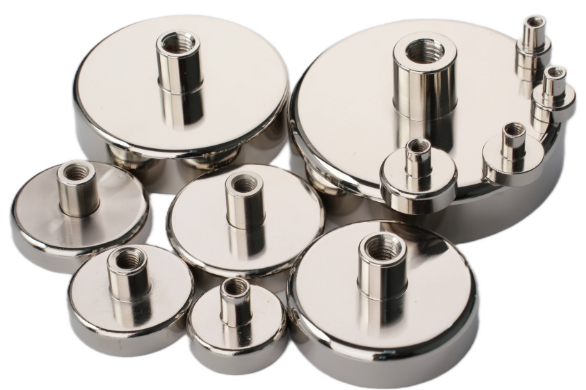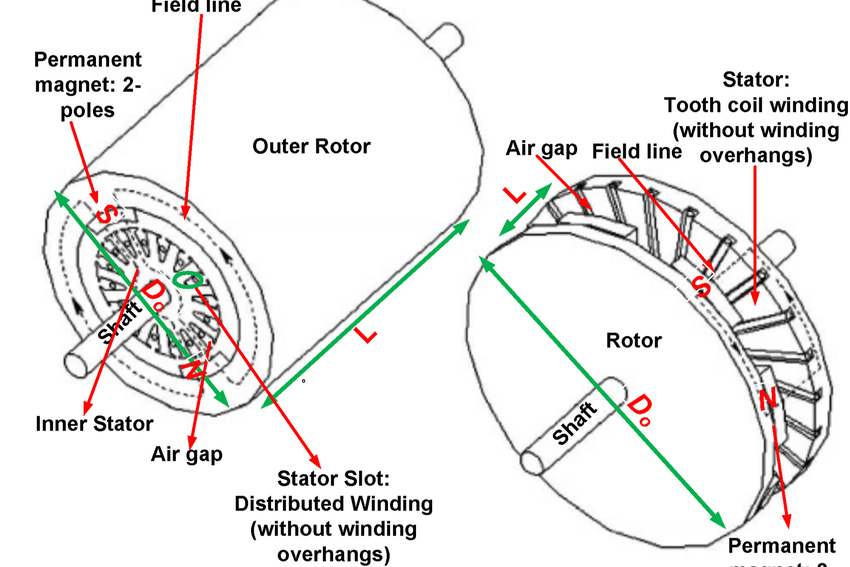Application of Neodymium Magnets in Wind Turbine Generators
The working environment of a wind turbine is very harsh, and it must be able to withstand the test of high temperature, severe cold, wind and sand, humidity, and even salt spray. Wind turbines are typically designed to last 20 years. At present, sintered NdFeB permanent magnets are used for both small wind turbines and megawatt permanent magnet wind turbines. In this article, let's take a closer look at the application of neodymium magnets in wind turbine generators.
 Application of Neodymium Magnets in Wind Turbine Generators
Application of Neodymium Magnets in Wind Turbine Generators
Magnetic Properties of Sintered NdFeB in Permanent Magnet Wind Generators
The main phase of the sintered NdFeB alloy is the intermetallic compound Nd2Fe14B, and its saturation magnetic polarization (Js) is 1.6T. Because the sintered NdFeB permanent magnet alloy is composed of the main phase Nd2Fe14B and the grain boundary phase, and the grain orientation of Nd2Fe14B is limited by the process conditions, the current magnet remanence can reach up to 1.5T.
The demagnetization curve of NdFeB at room temperature is similar to a straight line. Therefore, when designing permanent magnet motors, high-grade NdFeB magnets are often chosen to obtain high air gap magnetic density. When the motor is running, due to the existence of alternating demagnetizing field and the demagnetizing field caused by the instantaneous large current when the load suddenly changes, it is required to choose NdFeB magnets with sufficient coercivity.
Adding dysprosium (terbium) and other elements increases the intrinsic coercivity (Hc) of the NdFeB magnet, but the remanence (Br) of the magnet will decrease accordingly. Therefore, high-performance NdFeB magnets for wind generators take into account both coercivity and remanence.
Temperature Stability of NdFeB Magnets
Wind power generators work in the wilderness and endure the test of sweltering heat and severe cold. The Curie temperature of the neodymium magnet is about 310℃. When the temperature of the magnet exceeds the Curie point, it turns from ferromagnetism to paramagnetism.
Below the Curie temperature, the remanence of NdFeB decreases with increasing temperature, and its temperature coefficient of remanence α(Br) is -0.095~-0.105%/℃. The coercive force of NdFeB also decreases with the increase of temperature, and the temperature coefficient β (jHc) of the coercive force is -0.54~-0.64%/℃.
The Consistency of Magnetic Properties of the NdFeB Magnets in Wind Power Generators
NdFeB magnets are manufactured using a special powder metallurgy process, the main manufacturing process of which is completed in a protective atmosphere or in a vacuum. The NdFeB green body is pressed in a very strong (~1.5T) magnetic field. The size of NdFeB magnets is limited by these special processes.
A large permanent magnet wind generator usually uses thousands of neodymium magnets, and each pole of the rotor is composed of many magnets. The consistency of rotor poles requires the consistency of magnets, including the consistency of dimensional tolerances and magnetic properties. The so-called consistency of magnetic properties includes the small deviation of the magnetic properties between different individuals and the uniformity of the magnetic properties of a single magnet.
Conclusion
Thank you for reading our article and we hope it can help you to have a better understanding of the application of neodymium magnets in wind turbine generators. If you want to learn more about neodymium magnets or other types of magnets, we would like to advise you to visit Stanford Magnets for more information.
As a leading magnet supplier across the world, Stanford Magnets has been involved in R&D, manufacturing, and sales of magnets since the 1990s. It provides customers with high-quality permanent magnets like SmCo magnets, neodymium magnets, AlNiCo magnets, and ferrite magnets (ceramic magnets) at a very competitive price.















